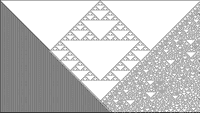Examples+
A Processing implementation of Game of Life
by Joan Soler-Adillon
Press SPACE BAR to pause and change the cell's values with the mouse. On pause, click to activate/deactivate cells. Press 'R' to randomly reset the cells' grid. Press 'C' to clear the cells' grid. The original Game of Life was created by John Conway in 1970.
Highlighted Features
/**
* Game of Life
* by Joan Soler-Adillon.
*
* Press SPACE BAR to pause and change the cell's values
* with the mouse. On pause, click to activate/deactivate
* cells. Press 'R' to randomly reset the cells' grid.
* Press 'C' to clear the cells' grid. The original Game
* of Life was created by John Conway in 1970.
*/
// Size of cells
int cellSize = 5;
// How likely for a cell to be alive at start (in percentage)
float probabilityOfAliveAtStart = 15;
// Variables for timer
int interval = 100;
int lastRecordedTime = 0;
// Colors for active/inactive cells
color alive = color(0, 200, 0);
color dead = color(0);
// Array of cells
int[][] cells;
// Buffer to record the state of the cells and use this
// while changing the others in the interations
int[][] cellsBuffer;
// Pause
boolean pause = false;
void setup() {
size (640, 360);
// Instantiate arrays
cells = new int[width/cellSize][height/cellSize];
cellsBuffer = new int[width/cellSize][height/cellSize];
// This stroke will draw the background grid
stroke(48);
noSmooth();
// Initialization of cells
for (int x=0; x<width/cellSize; x++) {
for (int y=0; y<height/cellSize; y++) {
float state = random (100);
if (state > probabilityOfAliveAtStart) {
state = 0;
}
else {
state = 1;
}
cells[x][y] = int(state); // Save state of each cell
}
}
// Fill in black in case cells don't cover all the windows
background(0);
}
void draw() {
//Draw grid
for (int x=0; x<width/cellSize; x++) {
for (int y=0; y<height/cellSize; y++) {
if (cells[x][y]==1) {
fill(alive); // If alive
}
else {
fill(dead); // If dead
}
rect (x*cellSize, y*cellSize, cellSize, cellSize);
}
}
// Iterate if timer ticks
if (millis()-lastRecordedTime>interval) {
if (!pause) {
iteration();
lastRecordedTime = millis();
}
}
// Create new cells manually on pause
if (pause && mousePressed) {
// Map and avoid out of bound errors
int xCellOver = int(map(mouseX, 0, width, 0, width/cellSize));
xCellOver = constrain(xCellOver, 0, width/cellSize-1);
int yCellOver = int(map(mouseY, 0, height, 0, height/cellSize));
yCellOver = constrain(yCellOver, 0, height/cellSize-1);
// Check against cells in buffer
if (cellsBuffer[xCellOver][yCellOver]==1) { // Cell is alive
cells[xCellOver][yCellOver]=0; // Kill
fill(dead); // Fill with kill color
}
else { // Cell is dead
cells[xCellOver][yCellOver]=1; // Make alive
fill(alive); // Fill alive color
}
}
else if (pause && !mousePressed) { // And then save to buffer once mouse goes up
// Save cells to buffer (so we opeate with one array keeping the other intact)
for (int x=0; x<width/cellSize; x++) {
for (int y=0; y<height/cellSize; y++) {
cellsBuffer[x][y] = cells[x][y];
}
}
}
}
void iteration() { // When the clock ticks
// Save cells to buffer (so we opeate with one array keeping the other intact)
for (int x=0; x<width/cellSize; x++) {
for (int y=0; y<height/cellSize; y++) {
cellsBuffer[x][y] = cells[x][y];
}
}
// Visit each cell:
for (int x=0; x<width/cellSize; x++) {
for (int y=0; y<height/cellSize; y++) {
// And visit all the neighbours of each cell
int neighbours = 0; // We'll count the neighbours
for (int xx=x-1; xx<=x+1;xx++) {
for (int yy=y-1; yy<=y+1;yy++) {
if (((xx>=0)&&(xx<width/cellSize))&&((yy>=0)&&(yy<height/cellSize))) { // Make sure you are not out of bounds
if (!((xx==x)&&(yy==y))) { // Make sure to to check against self
if (cellsBuffer[xx][yy]==1){
neighbours ++; // Check alive neighbours and count them
}
} // End of if
} // End of if
} // End of yy loop
} //End of xx loop
// We've checked the neigbours: apply rules!
if (cellsBuffer[x][y]==1) { // The cell is alive: kill it if necessary
if (neighbours < 2 || neighbours > 3) {
cells[x][y] = 0; // Die unless it has 2 or 3 neighbours
}
}
else { // The cell is dead: make it live if necessary
if (neighbours == 3 ) {
cells[x][y] = 1; // Only if it has 3 neighbours
}
} // End of if
} // End of y loop
} // End of x loop
} // End of function
void keyPressed() {
if (key=='r' || key == 'R') {
// Restart: reinitialization of cells
for (int x=0; x<width/cellSize; x++) {
for (int y=0; y<height/cellSize; y++) {
float state = random (100);
if (state > probabilityOfAliveAtStart) {
state = 0;
}
else {
state = 1;
}
cells[x][y] = int(state); // Save state of each cell
}
}
}
if (key==' ') { // On/off of pause
pause = !pause;
}
if (key=='c' || key == 'C') { // Clear all
for (int x=0; x<width/cellSize; x++) {
for (int y=0; y<height/cellSize; y++) {
cells[x][y] = 0; // Save all to zero
}
}
}
}
Related Examples
This example is for Processing 4+. If you have a previous version, use the examples included with your software. If you see any errors or have suggestions, please let us know.
